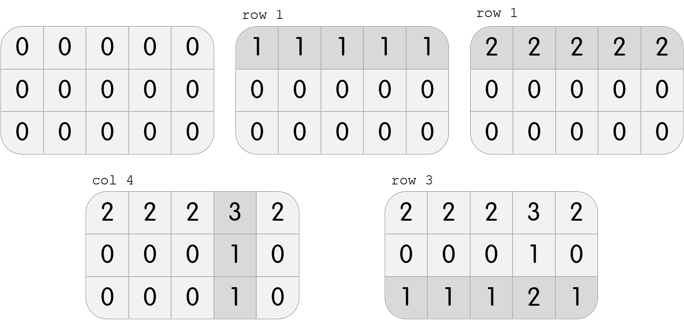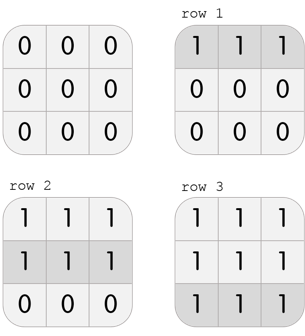On the way to school, Karen became fixated on the puzzle game on her phone!

The game is played as follows. In each level, you have a grid with n rows and m columns. Each cell originally contains the number 0.
One move consists of choosing one row or column, and adding 1 to all of the cells in that row or column.
To win the level, after all the moves, the number in the cell at the i-th row and j-th column should be equal to gi, j.
Karen is stuck on one level, and wants to know a way to beat this level using the minimum number of moves. Please, help her with this task!
The first line of input contains two integers, n and m (1 ≤ n, m ≤ 100), the number of rows and the number of columns in the grid, respectively.
The next n lines each contain m integers. In particular, the j-th integer in the i-th of these rows contains gi, j (0 ≤ gi, j ≤ 500).
If there is an error and it is actually not possible to beat the level, output a single integer -1.
Otherwise, on the first line, output a single integer k, the minimum number of moves necessary to beat the level.
The next k lines should each contain one of the following, describing the moves in the order they must be done:
- row x, (1 ≤ x ≤ n) describing a move of the form "choose the x-th row".
- col x, (1 ≤ x ≤ m) describing a move of the form "choose the x-th column".
If there are multiple optimal solutions, output any one of them.
3 5
2 2 2 3 2
0 0 0 1 0
1 1 1 2 1
4
row 1
row 1
col 4
row 3
3 3
0 0 0
0 1 0
0 0 0
-1
3 3
1 1 1
1 1 1
1 1 1
3
row 1
row 2
row 3
In the first test case, Karen has a grid with 3 rows and 5 columns. She can perform the following 4 moves to beat the level:

In the second test case, Karen has a grid with 3 rows and 3 columns. It is clear that it is impossible to beat the level; performing any move will create three 1s on the grid, but it is required to only have one 1 in the center.
In the third test case, Karen has a grid with 3 rows and 3 columns. She can perform the following 3 moves to beat the level:

Note that this is not the only solution; another solution, among others, is col 1, col 2, col 3.
因为是输出任意一组,而且只能+1,所以倒着每行每列考虑,看n和m谁小,若n小先把行处理完在处理列,反之同理。
#include <iostream>
#include <cstring>
#include <cmath>
#include <cstdio>
#include <string>
#include <algorithm>
#include <queue>
#include <vector>
#include <set>
#define inf 99999999
using namespace std;
typedef long long ll;
const int maxn = 100 + 10;
int a[maxn][maxn];
struct node {
string s;
int x;
node(string ss, int xx): s(ss), x(xx) {}
};
vector<node> v;
int n, m;
int main()
{
while (cin >> n >> m) {
v.clear();
bool flag = false;
for (int i = 1 ; i <= n ; i ++) {
for (int j = 1 ; j <= m ; j ++) {
cin >> a[i][j];
if (a[i][j] != 0)flag = true;
}
}
if (flag == false) {cout << "0" << endl; continue;}
for (int i = 1 ; i <= n ; i++) {
a[i][0] = inf;
for (int j = 1 ; j <= m ; j ++) {
a[i][0] = min(a[i][0], a[i][j]);
}
}
for (int j = 1 ; j <= m ; j ++) {
a[0][j] = inf;
for (int i = 1 ; i <= n ; i ++) {
a[0][j] = min(a[0][j], a[i][j]);
}
}
if (n <= m) {
for (int i = 1 ; i <= n ; i++) {
if (a[i][0] == 0)continue;
for (int k = a[i][0] ; k >= 1 ; k --) {
v.push_back(node("row", i));
}
for (int j = 1 ; j <= m ; j ++) {
a[0][j] = min(a[0][j], a[i][j] - a[i][0]);
}
for (int j = 1 ; j <= m ; j ++) {
a[i][j] -= a[i][0];
}
}
for (int j = 1 ; j <= m ; j++) {
if (!a[0][j])continue;
for (int k = 1 ; k <= a[0][j] ; k++) {
v.push_back(node("col", j));
}
for (int i = 1 ; i <= n ; i ++) {
a[i][j] -= a[0][j];
}
}
}
else {
for (int j = 1 ; j <= m ; j++) {
if (!a[0][j])continue;
for (int k = 1 ; k <= a[0][j] ; k++) {
v.push_back(node("col", j));
//cout << "col" << " " << j << endl;
}
for(int i = 1 ; i <= n ; i ++){
a[i][0] = min(a[i][0],a[i][j]-a[0][j]);
}
for (int i = 1 ; i <= n ; i ++) {
a[i][j] -= a[0][j];
}
}
for (int i = 1 ; i <= n ; i++) {
if (a[i][0] == 0)continue;
for (int k = a[i][0] ; k >= 1 ; k --) {
v.push_back(node("row", i));
}
for (int j = 1 ; j <= m ; j ++) {
a[i][j] -= a[i][0];
}
}
}
bool ok = false;
for (int i = 1 ; i <= n ; i ++) {
for (int j = 1 ; j <= m ; j ++) {
if (a[i][j] != 0)ok = true;
}
}
/*for(int i = 1 ; i <= n ; i ++){
for(int j = 1 ; j <= m ; j ++){
cout << a[i][j] << " ";
}
cout << endl;
}*/
if (ok) {cout << "-1" << endl; continue;}
if (v.size() == 0 && flag == true) {cout << "-1" << endl; continue;}
cout << v.size() << endl;
for (int i = v.size() - 1 ; i >= 0 ; i --) {
cout << v[i].s << " " << v[i].x << endl;
}
}
return 0;
}
























 被折叠的 条评论
为什么被折叠?
被折叠的 条评论
为什么被折叠?








